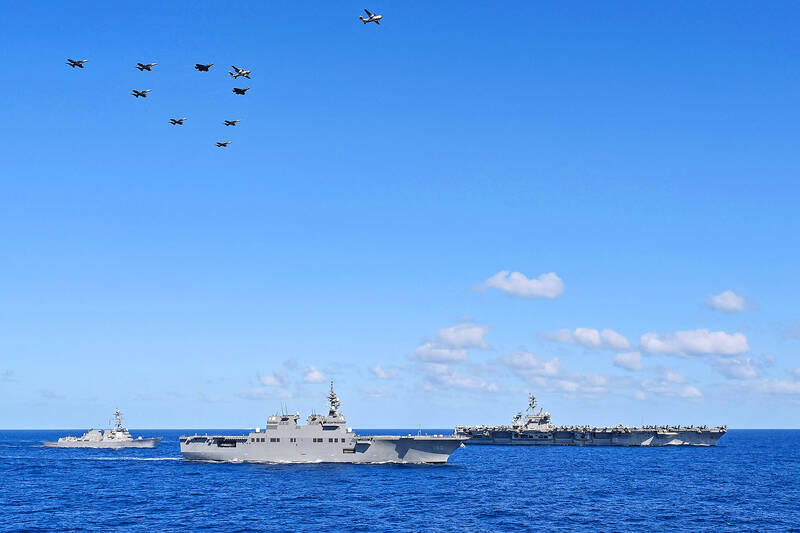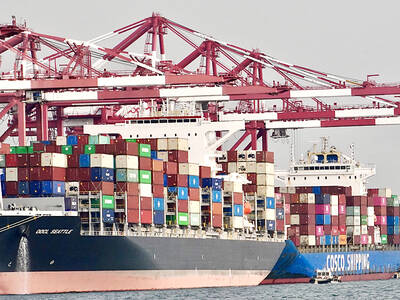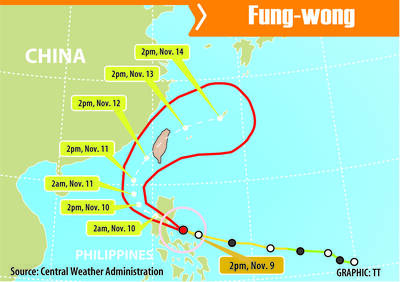Japan and the US are conducting joint military exercises with China as a hypothetical enemy for the first time, Japanese media on Sunday cited Tokyo officials as saying.
The Japan Self-Defense Forces and the US military set a possible Taiwan contingency as the main scenario for their highest-level military exercise Keen Edge, which began on Thursday last week and is scheduled to end on Thursday, Kyodo News reported.
Keen Edge is a biennial command post training drill in which Japanese and US military employ computer simulations to practice responses in the event of a crisis or contingency, the US Indo-Pacific Command said.

Photo: AFP
Japanese General Yoshihide Yoshida, the head of the Japan Self-Defense Forces, told a news conference on Jan. 25 that Japan and the US “did not envision a particular country or region” for the exercise, the Japan Times reported.
However, Kyodo News cited “multiple government officials” as saying that China was the hypothetical enemy.
Compared with past exercises, which used tentative names for hypothetical enemies, the current exercise is conducted under a much more concrete assumption, it said.
The Japanese Ministry of Defense is believed to have classified the scenario as a specially designated secret protected by Japan’s State Secrecy Law, it said.
Amid growing concerns that China would invade Taiwan within the next few years, naming a hypothetical enemy indicated a strong sense of urgency shared by Japan and the US, it said.
In previous exercises, Japan and the US used maps that slightly differed from the topography of actual countries to “avoid a backlash in the event the plans were leaked,” but switched to unaltered maps in the current exercise, the Japan Times reported.
Japan and the US have drawn up several joint operation plans in preparation for possible contingencies, with a draft envisioning a Taiwan contingency being completed at the end of last year, Kyodo News said.
The two sides are said to finalize the drafted plan by the end of this year based on the results of the current exercise, it said.
Troops are expected to carry out the plan during the field training exercise Keen Sword next year to verify its efficacy, it said.

The Central Weather Administration (CWA) yesterday said it expected to issue a sea warning for Typhoon Fung-Wong tomorrow, which it said would possibly make landfall near central Taiwan. As of 2am yesterday, Fung-Wong was about 1,760km southeast of Oluanpi (鵝鑾鼻), Taiwan’s southernmost point, moving west-northwest at 26kph. It is forecast to reach Luzon in the northern Philippines by tomorrow, the CWA said. After entering the South China Sea, Typhoon Fung-Wong is likely to turn northward toward Taiwan, CWA forecaster Chang Chun-yao (張峻堯) said, adding that it would likely make landfall near central Taiwan. The CWA expects to issue a land

Taiwan’s exports soared to an all-time high of US$61.8 billion last month, surging 49.7 percent from a year earlier, as the global frenzy for artificial intelligence (AI) applications and new consumer electronics powered shipments of high-tech goods, the Ministry of Finance said yesterday. It was the first time exports had exceeded the US$60 billion mark, fueled by the global boom in AI development that has significantly boosted Taiwanese companies across the international supply chain, Department of Statistics Director-General Beatrice Tsai (蔡美娜) told a media briefing. “There is a consensus among major AI players that the upcycle is still in its early stage,”

The Central Weather Administration (CWA) yesterday said it is expected to issue a sea warning for Typhoon Fung-wong this afternoon and a land warning tomorrow. As of 1pm, the storm was about 1,070km southeast of Oluanpi (鵝鑾鼻), Taiwan’s southernmost point, and was moving west-northwest at 28 to 32kph, according to CWA data. The storm had a radius of 250km, with maximum sustained winds of 173kph and gusts reaching 209kph, the CWA added. The storm is forecast to pass near Luzon in the Philippines before entering the South China Sea and potentially turning northward toward Taiwan, the CWA said. CWA forecaster Chang Chun-yao (張峻堯) said

PREPARATION: Ferry lines and flights were canceled ahead of only the second storm to hit the nation in November, while many areas canceled classes and work Authorities yesterday evacuated more than 3,000 people ahead of approaching Tropical Storm Fung-wong, which is expected to make landfall between Kaohsiung and Pingtung County this evening. Fung-wong was yesterday morning downgraded from a typhoon to a tropical storm as it approached the nation’s southwest coast, the Central Weather Administration (CWA) said, as it issued a land alert for the storm. The alert applies to residents in Tainan, Kaohsiung, Pingtung and Taitung counties, and the Hengchun Peninsula (恆春). As of press time last night, Taichung, Tainan, Kaohsiung, and Yilan, Miaoli, Changhua, Yunlin, Pingtung and Penghu counties, as well as Chiayi city and county had